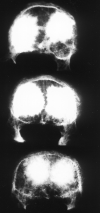Ex vivo biomechanical comparison of hydroxyapatite and polymethylmethacrylate cements for use with vertebroplasty
- PMID: 12427616
- PMCID: PMC8185850
Ex vivo biomechanical comparison of hydroxyapatite and polymethylmethacrylate cements for use with vertebroplasty
Abstract
Background and purpose: Little is known about the mechanical stabilization afforded by new materials proposed for use with vertebroplasty. This comparative ex vivo biomechanical study was designed to determine the strength and stiffness of osteoporotic vertebral bodies (VBs) subjected to compression fractures and stabilized with bipedicular injections of Cranioplastic altered in a manner consistent with the practice of vertebroplasty or BoneSource cement.
Methods: VBs T8-T10 and L2-L4 from 10 fresh spines were harvested from female cadavers (aged 91.5 years +/- 3.9 at death). These were screened for bone density (t score, -4.9 +/- 1.4; bone mineral density, 0.61 g/cm(2) +/- 0.19), disarticulated, and compressed to determine initial strength and stiffness. The fractured VBs were stabilized with bipedicular injections of a predetermined quantity and type of cement and then re-crushed.
Results: At both the thoracic and lumbar levels, VBs repaired with altered Cranioplastic resulted in significantly greater strength (P <.05) than that in their prefracture states, whereas those repaired with BoneSource were restored to their initial strength. Cranioplastic resulted in significantly stronger repairs than BoneSource in the thoracic region; however, repair strengths in the lumbar region were not significantly different. The repaired stiffness was significantly lower than the initial stiffness in all treatments and in both regions. Differences in the repaired stiffness between the treatment groups in either region and differences in the mechanical parameters obtained by adding an additional 2 mL of BoneSource were not significant.
Conclusion: Both materials in the volumes used either restored or increased VB strength, but none restored stiffness.
Figures


References
-
- Deramond H, Wright NT, Belkoff SM. Temperature elevation caused by bone cement polymerization during vertebroplasty. Bone 1999;25(2 suppl):17S–21S - PubMed
-
- Belkoff SM, Mathis JM, Jasper LE, Deramond H. An ex vivo biomechanical evaluation of a hydroxyapatite cement for use with vertebroplasty. Spine 2001;26:1542–1546 - PubMed
-
- Jasper LE, Deramond H, Mathis JM, Belkoff SM. Material properties of various cements for use with vertebroplasty. J Mater Sci Mater Med 2002;13:1–5 - PubMed
-
- Belkoff SM, Mathis JM, Erbe EM, Fenton DC. Biomechanical evaluation of a new bone cement for use in vertebroplasty. Spine 2000;25:1061–1064 - PubMed
Publication types
MeSH terms
Substances
LinkOut - more resources
Full Text Sources
Medical
Research Materials
